In today’s landscape of heightened cyber threats and data breaches, the demand for immutable, tamper-resistant snapshots is growing rapidly. Often this need arises as part of a broader security mandate, ideally proactively, but oftentimes as a response to a security incident. OneFS addresses this requirement in the following ways:
| On-cluster | Off-cluster |
| · Read-only snapshots
· Snapshot locks · Role-based administration · Secure snapshots with multi-party authorization |
· SyncIQ snapshot replication
· SmartSync snapshot replication · Cyber-vaulting
|
As we have seen over the course of this series of articles, the primary objective of Secure Snapshots, introduced in OneFS 9.12, is to ensure snapshot immutability, safeguarding them from accidental changes or deliberate tampering. Beyond protecting the snapshots themselves, Secure Snapshots also secures the associated snapshot schedules. Since these schedules govern the creation of future snapshots, any unauthorized modifications could lead to unintended outcomes—such as excessive snapshot generation that strains the cluster, or a complete halt in snapshot creation.
Secure Snapshots are built on the OneFS multi-party authorization (MPA) framework, which requires additional approvals before any changes can be made to snapshot configurations or schedules, effectively preventing unauthorized actions.
The Secure Snapshots functionality is in addition and complementary to traditional SnapshotIQ locking, which operates under the purview or the ‘isi snapshot locks’ CLI command set. As such, Secure Snapshots do not affect the addition, removal, or general operation of the regular SnapshotIQ snapshot locks.
| Feature | Availability | Authorization | Description |
| Secure snapshots | OneFS 9.12 and later | Multiple approvers | One or more additional approvers must authorize snapshot privileged action. |
| SnapshotIQ locks | OneFS 7.0 and later | Single approver | A single administrator can configure and manage snapshot locks. |
While SnapshotIQ locks help prevent snapshots from being accidentally or unintentionally deleted, unlike Secure Snapshots, they do not offer the additional anti-tamper protection of Multi-party Authorization (MPA).
SnapshotIQ locks function as follows. For example, a manual snapshot, ‘snaploc1’ is taken of /ifs/test:
# isi snapshot snapshots create /ifs/test --name snaploc1 # isi snapshot snapshots list | grep snaploc1 79188 snaploc1 /ifs/test
A lock is then placed on it (in this case lock ID=1):
# isi snapshot locks create snaploc1 # isi snapshot locks list snaploc1 ID ---- 1 ---- Total: 1
Or from the WebUI:
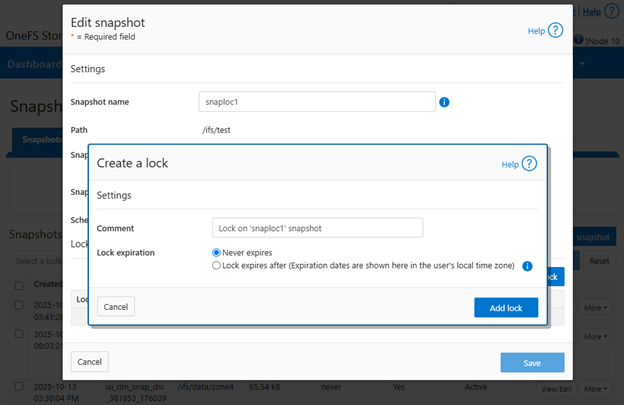
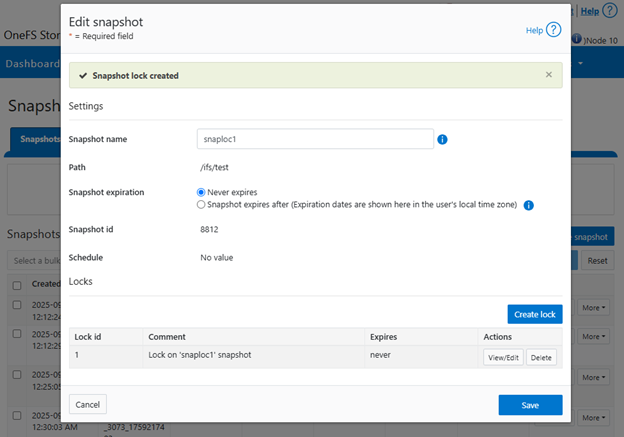
Attempts to delete the snapshot fails because the lock prevents its removal:
# isi snapshot snapshots delete snaploc1 Are you sure? (yes/[no]): yes Snapshot "snaploc1" can't be deleted because it is locked
The CLI command ‘isi snapshot locks delete <lock_ID>’ can be used to clear existing snapshot locks, if desired. For example, to remove the only lock (ID=1) from snapshot ‘snaploc1’:
# isi snapshot locks list snaploc1 ID ---- 1 ---- Total: 1 # isi snapshot locks delete snaploc1 1 Are you sure you want to delete snapshot lock 1 from snaploc1? (yes/[no]): yes # isi snap locks view snaploc1 1 No such lock
Or from the WebUI:
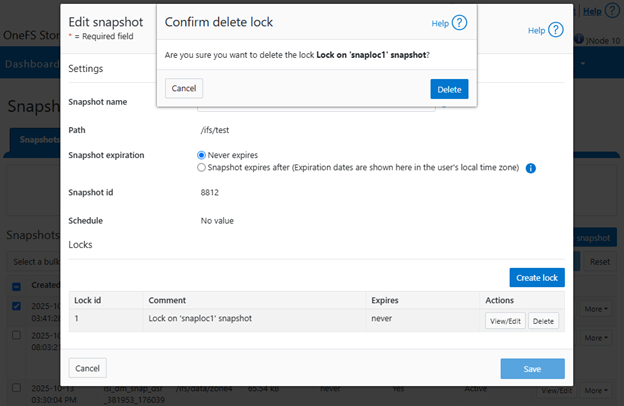
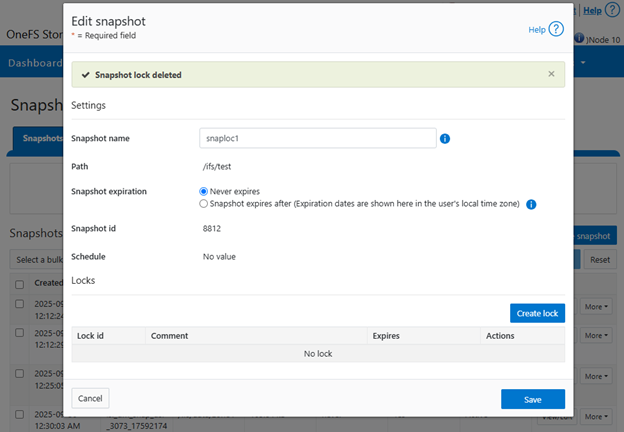
Once the lock is removed, the snapshot can then be deleted:
# isi snapshot snapshots delete snaploc1 Are you sure? (yes/[no]): yes # isi snapshot snapshots list| grep -i snaploc1 | wc -l 0
A snapshot can have up to a maximum of sixteen SnapshotIQ locks on it at any time. Also, lock numbers are continually incremented and not recycled upon deletion.
Similar to snapshot expiry configuration, snapshot locks can also have an expiry time configured too. For example, to set a lock on snapshot ‘snaploc1’ that expires at 12pm on April 1st, 2026:
# isi snap lock create snaploc1 --expires '2026-04-01T12:00:00' # isi snap lock list snaploc1 ID ---- 36 ---- Total: 1 # isi snap lock view snaploc1 33 ID: 36 Comment: Expires: 2026-04-01T12:00:00 Count: 1
Or from the WebUI:
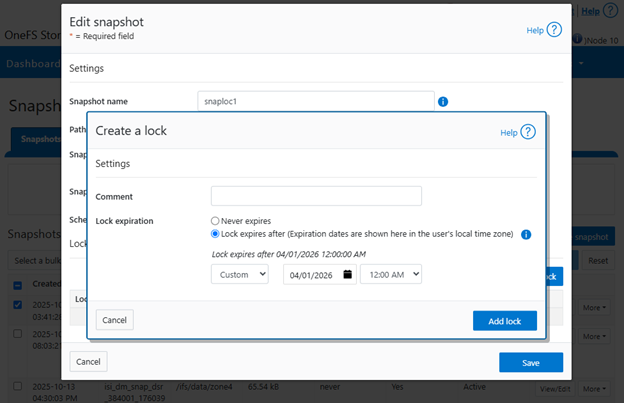
Note that if the duration period of a particular snapshot lock expires but others remain, OneFS will not delete that snapshot until all the locks on it have been removed or expired.